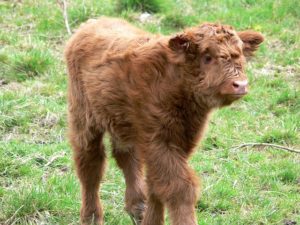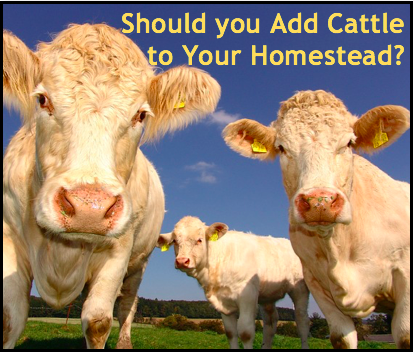If you’re considering cattle as an addition to your homestead, you’re probably well on your way to total self-sufficiency — if you’re not there already. Chickens, ducks, goats, and sheep are all good starting animals. Just like with each species, cows have their own unique needs. Being able to make sure you can care for them and legally have them are the first, and most important, steps.
Determine Your Needs
When you’re starting out, there are a few important things to consider before you add cattle. The first is understanding that cattle need more room than goats and ducks. While you won’t need 300 acres for a personal herd, you’ll need enough land for them to exercise and graze on. There is plenty of information out there on having a backyard homestead! If you plan to start off with dairy cattle, like many people do, then differentiating between dairy cattle and meat cattle needs is also important.
If you’re interested in dairy cows, usually one cow is sufficient for a family. However, it might be beneficial to the cow to have two! That’s because cows are very social animals, and they actually have best friends. As good as you are to your animals, you still won’t actually be a cow. Keeping them healthy, both physically and mentally, is an important aspect of getting the most for your money. Plus, then you can use the extra milk to trade with other homesteaders!
For beef bulls, you can either get them from the dairy cows, as many homesteaders do, or you can work with other homesteads to acquire them. Of course, if you’re happy with the meat you get from goats and sheep, there isn’t any reason you have to have beef. You can simply sell the bulls to others who have need of them.
Breeds
There are a variety of different breeds of cows. Some are best for dairy, and some are best for meat. If you intend to have primarily dairy cows, you can still get meat as you will probably have some bulls born to your producing cows.
 Some of the dairy breeds include the ever popular Jersey cow, Brown Swiss, Milking Shorthorn, Dexter and the American Milking Devon. All of these breeds produce milk at about four percent butter fat, but their output varies. The Dexter produces the least milk, at about two gallons a day. However, it is known for having good, lean beef. The Brown Swiss produces the most milk, at about nine gallons a day. Their milk is excellent for making cheese, but you may not have a need for that much milk!
Some of the dairy breeds include the ever popular Jersey cow, Brown Swiss, Milking Shorthorn, Dexter and the American Milking Devon. All of these breeds produce milk at about four percent butter fat, but their output varies. The Dexter produces the least milk, at about two gallons a day. However, it is known for having good, lean beef. The Brown Swiss produces the most milk, at about nine gallons a day. Their milk is excellent for making cheese, but you may not have a need for that much milk!
The Milking Shorthorn is the largest dairy breed, produces an average of six gallons of milk a day and is excellent for both dairy and beef. It is a popular breed and relatively easy to find. However, as the largest breed, it might be a bit more difficult to manage!
If you intend to breed and sell your cattle, then the American Milking Devon is your jackpot. These cows are excellent homestead animals, are quite rare and are in high demand. Taking the time to find and breed them would certainly pay off in the long run.
Preparation
If you’ve decided on your animals, you need to make sure your land will support them. Grass is necessary for optimal dairy and beef production, but you need the right amount of land and fertilizer to make sure the grass you provide is as good as it can be. You don’t want to try to feed your cattle on a poor pasture — it simply won’t be good for them.
You will probably also want to include grain in your meal plan for the animals. Not only is it vital to keep them well fed during the winter, but careful regulation of their diet is also important to prevent milk fever during calving. Typically, grain supplements and high-quality hay are the best substitutes for pastures during the winter.
As far as taking care of your herd, it’s important to understand that sometimes you will need to cull. A poor-producing animal will likely remain a poor-producing animal, while taking up the same amount of resources as a better one. It will only benefit you to either use it for meat or sell it.
Housing
Last, but certainly not least, you need to keep your cattle safe. This applies to whatever kind you have. They will need shelter and easy access to water year-round. Calves and yearlings may need additional warmth if the winter is especially hard. Proper feeding and monitoring of the animal’s diet is also important to keep them in good health.
Of course, you’ll also need good fencing! A mild electric fence is best, but you might be able to get away with a non-electric fence if yours is sturdy enough and you have a very small herd. A good fence will also help keep predators out. Cows, in particular, will need an enclosed space if you live somewhere with harsh winters. If you are unlikely to see snow and ice, then an open shelter may be sufficient.
No matter what, adding cows to your homestead is sure to be an adventure! Be prepared for the bills, commitment and infrastructure, and you and your cattle will both be very happy!
 Bobbi Peterson loves writing and regularly posts on her blog Living Life Green. She’s also a freelance writer, green living advocate and environmentalist. You can find more from Bobbi on Twitter.
Bobbi Peterson loves writing and regularly posts on her blog Living Life Green. She’s also a freelance writer, green living advocate and environmentalist. You can find more from Bobbi on Twitter.




